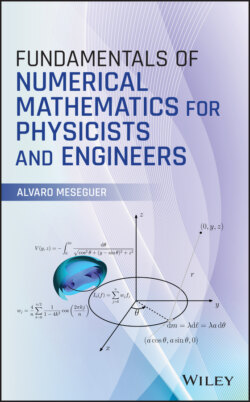Читать книгу Fundamentals of Numerical Mathematics for Physicists and Engineers - Alvaro Meseguer - Страница 24
Problems and Exercises
ОглавлениеThe symbol (A) means that the problem has to be solved analytically, whereas (N) means to use numerical Matlab codes. Problems with the symbol * are slightly more difficult.
1 1. (A) Consider the bisection method starting from the interval . Let be the resulting bisection sequence satisfying . Let be a given tolerance.How many iterations are required in order to satisfy that ?Once that tolerance has been reached, how many iterations should be added to have one more digit of precision?
2 2. (N) Apply the bisection algorithm to solve the equations over the intervals indicated below. Provide the numerical approximation of the root with at least 10 significant digits and also report how many bisections were required to achieve that accuracy., ., ., .
3 3. (A) Show that the chord method starting within the interval with has linear convergence to the root and obtain its corresponding asymptotic error constant . If for linear convergence, what constraints does this condition impose? Will the method converge linearly to a double root?
4 4. (A)* Show that the secant method converges superlinearly with order of convergence . As a hint, use Taylor's expansion to show that the errors obey (to the lowest order) the recurrence: .Next, assume that the absolute error obeys the relation , with in order to provide the value of the exponent as well as the asymptotic error constant .
5 5. (N) Using your own codes for the chord and secant methods, solve the equation starting from the interval and reproduce the results of Figure 1.2b.
6 6. (N) Regula Falsi or false position method: this root‐finding algorithm is in essence a globally convergent version of the secant method. Starting from the interval satisfying , proceed with the iterationwhere is the last iterate satisfying , that is,You need to modify your secant method code by storing the history of the iterates in order to include the condition above.Solve again the cubic starting from the interval and compute its local order of convergence based on the sequence obtained. What order can you identify?Solve (see Figure 1.4b) starting from initial intervals containing either or and convince yourself that the method is globally convergent within those intervals. In particular, verify for a few values of that .
7 7. (A) Applying Newton's method to a certain equation leads to the iteration , with . Find the original equation or, equivalently, find the purpose of such iteration and its corresponding limit .
8 8. (A) We apply Newton's method to solve starting from . How many iterations are required to obtain the root with an error of ? Solve the problem analytically. After that, verify your estimation numerically.
9 9. (A) For , find the value of the quantity Hint: is the limit of the sequence
10 10. (A–N) One technique to accelerate Newton's method for roots of multiplicity consists of replacing the original equation by the auxiliary one , where .If is a root of with multiplicity , find the limit .If the modified Newton's iteration using the auxiliary equation reads , find .If we use the original Newton's method to solve starting from , find the minimum number of iterations such that .Repeat (c) using the auxiliary equation.
11 11. (A–N) Steffensen's root‐finding method is given by the iterationStarting from the initial guess , apply the method to solve . What order of convergence can you identify?Solve starting also from . Do you observe the same exponent as in part (a)?(*) Find the exact order of convergence of the method for simple roots, as well as its corresponding asymptotic constant.
12 12. (A–N) Halley's13 root‐finding method is an algorithm that improves Newton's quadratic convergence when solving . In this case, the method solves the auxiliary equation , where and is assumed to be positive and differentiable within the domain containing the root.Find the resulting iterative formula in terms of , , and .Find the root of within using Halley's method starting from . Can you identify the order of convergence ?
13 13. (A–N) Dynamics and Kinematics: A trapeze artist is at rest on top of a platform of height (hollow circle A in the following figure) holding a rigid rod of length and negligible mass that can rotate around the fixed point O. The performer starts falling under the effect of gravity (dashed gray curve), passing through point at maximum speed without touching the ground. Later, the acrobat releases the rod when the angle it forms with the vertical axis is (point B). From point B onward, the artist traces a parabolic trajectory, finally touching the ground at point C, whose abscissa is . Neglect friction forces.Show that .Find the angle for which .What is the angle so that the acrobat maximizes the range ?Provide your numerical answers with at least four exact figures. Advice: for parts (b) and (c), consider the alternative equation
